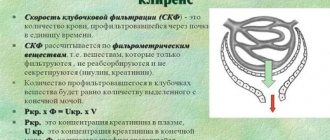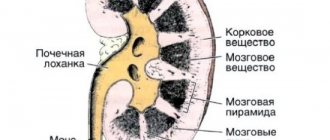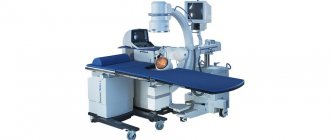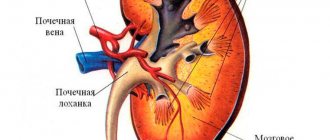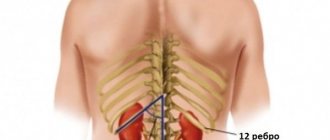Formula CKD-EPI
CKD-EPI is calculated using the following recommended formula:
eGFR = 141 × min(SCr/k, 1)a × max(SCr/k, 1)-1.209 × 0.993Age × GenK × RaceK , where
SCr—creatinine value in mg/dl; k - coefficient: for men - 0.9, for women - 0.7; a - coefficient: for men - -0.411, for women - -0.329;
min — the minimum number between the calculated value and 1 is taken, max — the maximum,
Age - age; GenK - gender coefficient: for men - 1, for women - 1.018; RaceK - racial coefficient: for blacks - 1.159, for Asians - 1.057, for Hispanics and Indians - 1.014, for whites and others - 1.
Type 1 diabetes mellitus in children and chronic kidney disease
Currently, the problem of diabetes mellitus (DM) is a priority for healthcare systems in all countries of the world. It is this disease that becomes one of the main causes of blindness, heart attacks, strokes and kidney failure [4]. It is not without reason that the 61st UN Assembly adopted a Resolution on the global threat of non-communicable chronic disease - diabetes mellitus and complications associated with this disease, “carrying not only a high danger to the health of all nations, but also colossal economic losses” [6]. In recent decades, diabetes has increasingly occurred in childhood, which dramatically affects the child’s quality of life, leading to early development of complications, disability and reduced life expectancy. Of course, in most cases, the incidence of diabetes among children is type 1, the so-called “diabetes of the young.” But at the same time, more than 80% of children with type 1 diabetes have specific microvascular complications in the form of damage to the eyes, peripheral nervous system, skin, and kidneys [5, 6].
One of the most dangerous vascular complications of diabetes is diabetic nephropathy (DN), which is a specific kidney damage in diabetes, characterized by the development of nodular or diffuse glomerulosclerosis, leading to the development of end-stage chronic renal failure (CRF) [6, 11]. It is known that DN is the cause of death in 50–75% of patients with onset of diabetes before the age of 20 years. It was previously thought that DN in childhood was extremely rare. However, epidemiological studies in recent years conducted in different countries show that from 3% to 20% of children and adolescents have DN [5].
In 2002, the term “chronic kidney disease” (CKD) was proposed as a general concept that clarifies the phase and severity of renal processes of various origins [13, 14]. Currently, CKD is interpreted as a supranosological concept that unites all patients with signs of kidney damage and/or decreased function, assessed by glomerular filtration rate (GFR), that persist for 3 months or more [2, 13]. The criteria for diagnosing CKD are currently recognized:
1) presence of any markers of kidney damage:
a) clinical and laboratory (primarily, increased albuminuria/proteinuria, confirmed by repeated studies and persisting for at least three months); b) irreversible structural changes in the kidney identified by radiation examination (for example, ultrasound) or morphological examination of a renal biopsy;
and/or
2) a decrease in GFR to a level of <60 ml/min/1.73 m2, persisting for three or more months.
Five stages of CKD are distinguished based on a combined determination of the degree of reduction in GFR and the severity of albuminuria/proteinuria [9, 10, 13].
Currently, the reversibility of kidney damage in the early stages of CKD has been proven, subject to timely and adequate therapy [9, 10]. Therefore, timely diagnosis of DN in childhood and adolescence can decisively determine the patient’s quality of life and prognosis [11].
The aim of this study was to identify and stratify renal dysfunction in children with type 1 diabetes according to the concept of CKD.
Materials and research methods
The work is based on the results of observation of 125 patients with type 1 diabetes aged 4 to 18 years. Anamnestic and clinical data and the results of additional examination were assessed [1, 7]. Laboratory methods included blood and urine tests, glycemic profile, serum glucose levels, total protein, protein profile, lipid spectrum, urea, creatinine, glycosylated hemoglobin. Albuminuria was determined by quantitative turbodimetric method. GFR was calculated using the Schwartz formula:
GFR = height (cm)/creatinine (µmol/l) × ratio (ml/min/1.73 m2).
The criterion for decreased renal function was considered to be a level of GFR standardized to body surface area below 90 ml/min/1.73 m2.
The content of cystatin C in blood serum was determined by the immunoturbodimetric method (DiaSys, Germany). To calculate GFR from cystatin C concentration, Hawke's equation was used:
GFR [ml/min/1.73 m2] = (80.35/cystatin C [mg/l]) – 4.32.
The patients were divided into two groups. The main group included 29 children with type 1 diabetes and DN. The diagnosis of DN was made in accordance with the St. Vincent Declaration of the DN Screening Program (1999). The comparison group consisted of 96 children with type 1 diabetes without DN. The presence of CKD and its stage was established according to the National Guidelines for CKD (2012).
Mathematical analysis of digital material was carried out using the Statistica 10.0 application package (StatSoft Inc., USA). When processing data for extended variables, the arithmetic mean (M) and standard deviation (SD) were calculated. Differences were considered significant at a level of p < 0.05.
Results and its discussion
As a result of a biochemical examination, it was revealed that the median daily urinary excretion of albumin in DN is more than 10 times higher than that in children in the comparison group (Fig. 1).
A study of 24-hour urine in the main group revealed a high degree of albuminuria, corresponding to stage A2, in 100% of cases (Table 1). Fluctuations in this indicator ranged from 32 to 282, the median was 61.5 [39.0–200.0] mg/day. In the comparison group, urinary albumin excretion in 43.8% of patients was less than 10 mg/day (stage A0), and in 56.2% its values were in the range from 10 to 29 mg/day (stage A1).
The concentration of creatinine, as the main marker for assessing GFR, was within the reference values in all children, but in the main group this indicator still recorded higher values than in the comparison group - 57.2 [45.0–71.4] mmol /l versus 44.0 [38.9–55.7] mmol/l (p < 0.05). However, GFR values calculated using the Schwartz formula are almost equal in patients with and without DN: 165 [145.0–191.5] ml/min and 158.0 [134.0–208.0] ml/min, respectively ( p > 0.05).
A more informative method for assessing renal dysfunction is currently considered to be the calculation of GFR based on cystatin C, which, unlike creatinine, is freely filtered through the glomerular membrane, but is not secreted by the proximal tubular system of the kidneys [3, 8, 12, 15, 16]. According to our data, the concentration of cystatin C in the blood serum of children in the comparison group is 0.77 [0.70–0.86] mg/l, which corresponds to the values of healthy children - 0.77 [0.69–0.82] mg /l. In patients with DN it is significantly higher - 1.10 [1.06–1.20] mg/l (p < 0.005). GFR, calculated based on the level of cystatin C, in patients with DN, as expected, turned out to be significantly lower: 68.0 [62.6–73.0] ml/min versus 102.0 [92.0–115.0] (p < 0.005; Fig. 2).
In accordance with the stratification of CKD stages according to the level of GFR and albuminuria, children with DN had stage C2A2 (82.8%) or C3aA2 (17.2%) CKD, corresponding to an initial or moderate decrease in renal function (Fig. 3).
In the group without DN, none of the patients had a GFR less than 60 ml/min, that is, there were no criteria for diagnosing CKD.
However, in some patients without DN (21 children), despite normal GFR values based on creatinine and an albuminuria level of less than 30 mg/day, there was an increase in the serum concentration of cystatin C, accompanied by a decrease in GFR. It was found that these patients had a longer duration of diabetes, combined complications of the disease, they were more likely to have a persistent increase in blood pressure, higher levels of total cholesterol, triglycerides, glycated hemoglobin and microalbuminuria compared to children with normal levels of cystatin C in the blood serum (Table .2). This makes it possible to classify them as a high-risk group for the formation of DN.
conclusions
Thus, the majority of children with DN exhibit clinical and laboratory symptoms corresponding to stage C2A2 of CKD; stage C3aA2 is less commonly diagnosed.
DN in childhood is characterized by an increase in serum cystatin levels. A comparative analysis of the calculation of GFR by two methods - according to the Schwartz formula and according to the level of cystatin C in the blood plasma - indicates a significantly higher information content of the latter in children. This biochemical test can be used for early diagnosis of kidney damage in diabetes.
An increase in the serum level of cystatin C in the absence of obvious signs of renal damage in a patient with type 1 diabetes should be regarded as a risk factor for CKD.
Literature
- Algorithms for specialized medical care for patients with diabetes mellitus / Ed. I. I. Dedova, M. V. Shestakova, A. Yu. Mayorov. 8th issue M.: UP PRINT, 2021. 112 p.
- Arkhipov V.V. The concept of chronic kidney disease in pediatrics - following adults, or Let's see what is offered to us // Nephrology. 2006. T. 10, no. 3. pp. 120–122.
- Velkov V.V. Cystatin S - new opportunities and new tasks for laboratory diagnostics: method. allowance. M.: Deacon, 2010. 72 p.
- WHO Global Diabetes Report 2021. https://www.who.int/.
- Dedov I.I., Peterkova V.A. Pediatric endocrinology: manual. M.: Universum Publishing, 2006. 595 p.
- Dedov I. I., Shestakova M. V. Diabetes mellitus: acute and chronic complications. M.: MIA, 2011. 478 p.
- Dedov I. I., Peterkova V. A. Federal clinical recommendations (protocols) for the management of children with endocrine diseases. M.: Praktika 2014. 446 p.
- Kiselnikova O.V., Spivak E.M., Mozzhukhina L.I. Cystatin C in assessing the glomerular filtration rate of the kidneys in children and adolescents // Perm Medical Journal. 2021. T. 34. No. 1. P. 63–66.
- Klimontov V.V., Myakina N.E. Chronic kidney disease in diabetes mellitus: textbook. allowance. Novosibirsk, 2014. 44 p.
- National recommendations. Chronic kidney disease: basic principles of screening, diagnosis, prevention and approaches to treatment / Ed. A. V. Smirnova. St. Petersburg: Levsha, 2012. 54 p.
- Shestakova M.V., Dedov I.I. Diabetes mellitus and chronic kidney disease. M.: MIA, 2009. 484 p.
- Hoek FJ, Kemperman FA, Krediet RT A comparison between cystatin C, plasma creatinine and the Cockroft and Gault formula for the estimation of glomerular filtration rate // Nephrol. Dial. Transplant. 2003. Vol. 18. R. 2024–2031.
- Kidney Disease: Improving Global Outcomes (KDIGO) CKD Work Group. KDIGO 2012 Clinical Practice Guideline for the Evaluation and Management of Chronic Kidney Disease // Kidney int. Suppl. 2013. Vol. 3. R. 1–150.
- National Kidney Foundation. KDOQI clinical practice guidelines and clinical practice recommendations for diabetes and chronic kidney disease // Am. J. Kidney Dis. 2007. Vol 49, No. 2, suppl 2. R. 9.
- Premaratne E. et al. Serial measurements of cystatin C are more accurate than creatinine-based methods in detecting declining renal function in type 1 diabetes // Diabetes Care. 2008. Vol. 31(5). P. 971–973.
- Macisaac RJ et al. The accuracy of cystatin C and commonly used creatinine-based thods for detecting moderate and mild chronic kidney disease in diabetes // Diabet Med. 2007. Vol. 24 (4). P. 443–448.
O. V. Kiselnikova*, 1, Candidate of Medical Sciences L. I. Mozzhukhina*, Doctor of Medical Sciences, Professor E. M. Spivak*, Doctor of Medical Sciences, Professor V. V. Tuz**
* Federal State Budgetary Educational Institution of Higher Education Yaroslavl State Medical University, Ministry of Health of the Russian Federation, Yaroslavl ** State Budgetary Institution of Healthcare of the Yaroslavl Autonomous Okrug of the CSTO, Yaroslavl
1 Contact information
Type 1 diabetes mellitus in children and chronic kidney disease / O. V. Kiselnikova, L. I. Mozzhukhina, E. M. Spivak, V. V. Tuz For citation: Attending physician No. 5/2019; Page numbers in the issue: 68-70 Tags: children, juvenile diabetes, kidney damage, albuminuria
